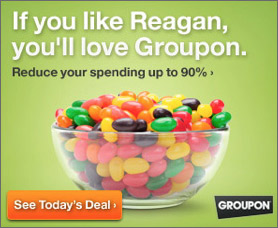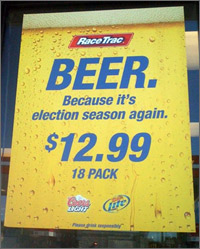Recently, a good friend who is a political reporter at a well-known ideological “hot spot” on the web sent me this Groupon Ad as an example of what we are in for this polarizing
political pageant in 2012.

So I ask, “Is this hard-core
pandering? Or just smart targeting?”
In our right vs. left society, marketers typically walk a very careful line, ideologically speaking, to not appear one way or another. Like a
delicate dance, brands tend to flap their flag whichever way the customer wind blows. Granted, some brands have already just gone out there and planted their flag by virtue of donations, speeches and
support. However, if The Blue Pages (the ideological buying guide for retailers) aren’t enough
to spur consumers to buy via cause marketing and consumer activism, then perhaps “ideological targeting” of ads are what we can expect?
advertisement
advertisement
Can’t we all just get along?
L ast fall, I saw this hilarious beer sign in the window of a
gas station. Funny, to-the-point and well-targeted, this ad was right down the middle, neither choosing sides or even a diagonal. Straight down the middle, in-your-face, “oh yeah, we feel your
pain” broad targeting.
ast fall, I saw this hilarious beer sign in the window of a
gas station. Funny, to-the-point and well-targeted, this ad was right down the middle, neither choosing sides or even a diagonal. Straight down the middle, in-your-face, “oh yeah, we feel your
pain” broad targeting.
So it begs the question, does where we go on the Web somehow “brand us” by our ideological leanings? Should a marketer know that or care? Is that
pandering or straight-up profiling?
The math says whether or not users are San Francisco Left or Deep South Right, they all need detergent and shoes, don’t they? Does it matter to you as
a marketer which side of the aisle their votes go? Does getting their allegiance as an ideologue make your product possibly more attractive?
While all media has its challenges in getting the
attention of a distracted digital user, is using the “short leash” of click path and behavioral tracks of a user off limits as it relates to “true targeting?” Naturally, most
political donations are a matter of public record, whether you are a company or an individual -- but should that “identifier” be carried over to the ad content as further insurance to get
the consumer to return?
There is already “lifestyle” targeted marketing to reach certain demographics. So is the Groupon ad merely an extension of that concept in the form of
“ideological” targeted marketing? Will it work?
Marketers have primarily been risk-averse to alienating any segment of the population. So this new, blatant strategy could
potentially be a provocative departure … or merely desperation. As the political polarity divides the nation and lines are being drawn (seemingly deeper now than before), is this possibly
marketing suicide? Is it okay to alienate potentially 50% of your potential audience by giving the proverbial middle finger to their choices of ideology?
Or is this so smart and innovative to
reach deep into the passions of the ideologue to prompt them to buy based upon emotion and allegiance? Are customers truly that black and white as it relates to red and blue? Most importantly, will
red, white, and blue help you see green? The questions are endless.
We all know behavioral targeting, used well and skillfully, can reach those uncommitted consumers at the right time and
place to bring them back. Knowing more about that consumer only makes the connection even stronger.
Knowing their political affiliation makes it potentially dangerous too.
Coloring
your customers red or blue and marketing to them in their respective groups is a big gamble. Should the messaging of your brand follow them all the way to the ballot box?
How will you
vote?